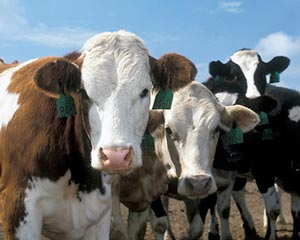 |
| A paper in the Proceedings of the National Academy of Sciences raises questions about consumption and food production. |
Sure, the perfectly prepared medium-rare steak you enjoyed last night was from a local farm that raises grass-fed cattle. And the mushrooms and onions saut├®ed on top? Organically grown, along with the steamed carrots and asparagus. The potatoes? They came from your neighbourÔÇÖs garden. And maybe you even picked the apples at a local orchard yourself to go in the apple crumble for desert.
But how much did you eat? How much do you eat in an average day? Week? Year? Now consider this on a global scale, how much do we collectively consume and what are the environmental impacts of our food choices?
A new paper released by Nathan Pelletier and Peter Tyedmers of the ╣¹¢┤╩ËãÁ University School for Resource and Environmental Studies raises some thought-provoking questions about consumption and production in our food systems and in particular, the livestock industry. ÔÇ£Forecasting potential global environmental costs of livestock production 2000-2050ÔÇØ has been published in the October 2010 edition of the Proceedings of the National Academy of Sciences of the United States of America.
Dr. Pelletier, a self confessed ÔÇ£foodieÔÇØ and ecological economist, is interested in studying food systems and how they effect the environment both at the local and global levels.
ÔÇ£Food is a really unique area of consumption in that we have a great deal of control over what and how much we choose to consume,ÔÇØ he says. ÔÇ£As a result, we also have direct control over the environmental implications of our dietary choices.ÔÇØ
Focusing on the global livestock industry, the paper explores the relationships between projected growth in livestock production and world-wide sustainability thresholds for human activity as a whole. The paper focuses on three domains: greenhouse gas emissions, reactive nitrogen mobilization and appropriation of plant biomass.
 |
Drs. Pelletier and TyedmersÔÇÖ research focuses on the 50-year period between 2000-2050. Using published data of the environmental impact of livestock production from the year 2000 and projections of livestock production and consumption from the United Nations Food and Agriculture Organization, the authors were able to estimate the potential environmental impacts in the 50-year period.
The news is not great.
It is estimated that global production of livestock will double in the next 50 years, which will in turn, greatly increase the environmental impacts of the livestock industry. Drs. Pelletier and Tyedmers estimate the livestock industry alone will account for 72 per cent of humanityÔÇÖs total ÔÇ£safe operating spaceÔÇØ for anthropogenic greenhouse gas emissions, 88 per cent of safe operating space for biomass appropriation and nearly 300 per cent of the safe operating space for reactive nitrogen mobilization.
Nitrogen plays a pivotal role in both our natural and agricultural ecosystems. It is the most abundant element in our atmosphere, but when the nitrogen cycle is overloaded, the consequences can be very serious. An abundance of nitrogen can lead to ecosystem simplification and a loss of biodiversity as well as contribute to global warming, acid precipitation and eutrophication of bodies of water.  Industrially-fixed nitrogen is a large component of commercial fertilizer but it is estimated that only 10 tp 20 per cent of the nitrogen applied to crops is actually consumed by humans. The remainder is lost to the environment. While reactive nitrogen is not directly used in livestock production, it is used to fertilize the crops and pastures that feed livestock.
It is estimated that nearly 60 per cent of the biomass currently harvested annually to support all human activities is consumed by the livestock industry. This underscores the dependence of this industry on biological productivity and raises some serious questions about the sustainability of devoting such a large portion to the livestock industry.
This doesnÔÇÖt mean that you should immediately stop eating burgers and steak and become a strict vegetarian. Human beings need protein to survive and livestock is a valuable source of protein and other nutrients. There are, however, also many other sources of protein that have the potential for a far less dramatic impact on the Earth.
For example, the paper also examines similar environmental projections that explore the implications of a shift away from livestock production to a more low impact source of protein such as poultry or soybeans. Although the authors stress that a total switch to poultry or soybeans is unrealistic, even a marginal decrease in livestock production would help to reduce environmental impact.
As consumers, we can also make a difference. ÔÇ£It is very well established that making changes in our diets can help reduce our individual and collective environmental impacts. What we need to focus on is a change in expectations. We need to re-establish appropriate levels of consumption in developed countries (where overconsumption of livestock products is prevalent), and curtail the rise of diets overly dependent on livestock products in the developing world. This will have both health and environmental benefits,ÔÇØ says Dr. Pelletier.
So maybe the next time youÔÇÖre in the grocery store, or farmers market, contemplating the 14-oz rib eye steak, opt instead for the chicken breast, or try that delicious tofu curry recipe you found on the Internet. Your planet will thank you.
LINK:
